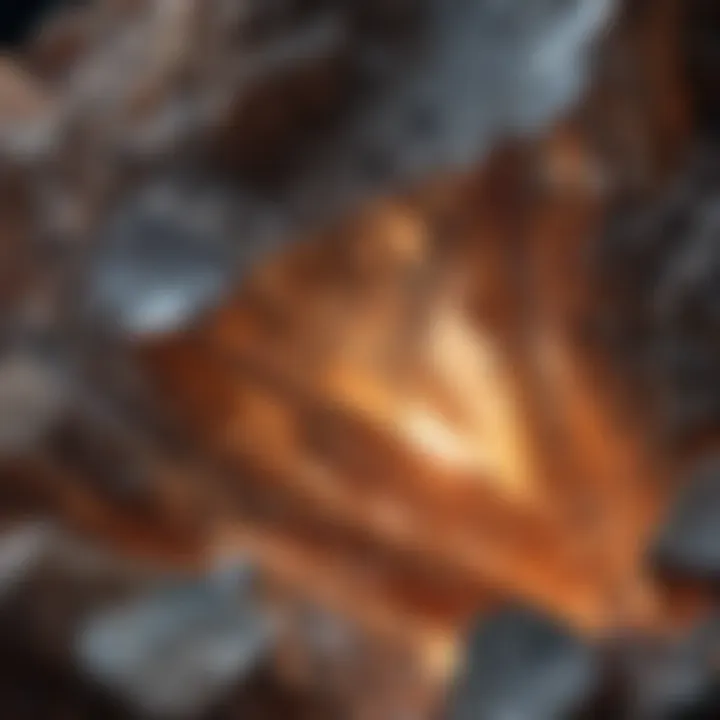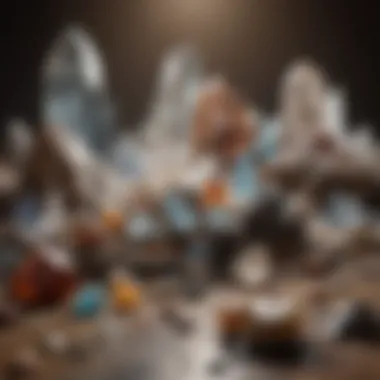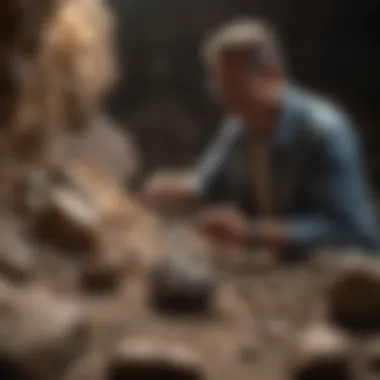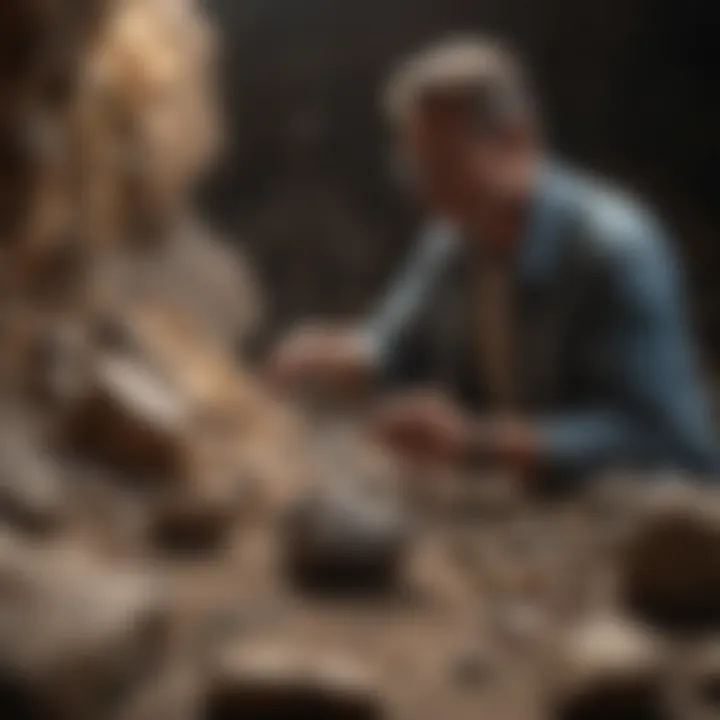Exploring Crystals in Rock Formations: A Deep Dive


Intro
The relationship between rocks and crystals is both complex and fascinating. Minerals are the building blocks of rocks, and when conditions are just right, crystals can form within these matrices. Understanding this relationship can offer insights into geological processes and the natural world.
Crystals can be found in various rock types, with each crystal having unique characteristics influenced by its environment. For rock and fossil collectors, grasping these intricacies can significantly enhance their appreciation and knowledge of the specimens they encounter. This article aims to illuminate the formation and classification of crystals within rock formations and discuss their significance in natural and human contexts.
Featured Collectible of the Month
Overview
This month, we spotlight the stunning quartz crystal. Quartz is one of the most abundant minerals on Earth. It is valued for both its beauty and usefulness. The crystal structure of quartz is hexagonal, and it can be found in a wide array of colors, like clear, amethyst, and citrine.
Collectors prize quartz for its versatility and the variety of shapes and forms in which it can be found. From shimmering clusters to solitary points, quartz displays exceptional beauty.
Historical Significance
Quartz has been used throughout history for various purposes, ranging from tools to ornamental objects. In ancient times, people believed quartz had healing properties and could protect against negative energies. Many cultures revered quartz, integrating it into their rituals and artistic expressions.
Today, quartz is not only a focal point in geology but also holds value for collectors and artisans alike. A clear understanding of its historical significance enriches the experience of both collecting and studying these beautiful formations.
Identification Techniques
Identifying crystals and their respective rock formations can be a challenging yet rewarding endeavor. It's crucial for collectors to hone their skills in recognizing the characteristics that differentiate one crystal from another.
Visual Characteristics
- Color: Different minerals present a wide range of colors. For instance, amethyst is known for its purple hue.
- Shape: Observe the external shape and internal structural features. Crystal faces and points can vary greatly.
- Luster: This refers to how light interacts with the mineral's surface. It can be metallic, glassy, or pearly.
- Hardness: Utilize the Mohs scale to assess the hardness of crystals against other materials.
- Translucency: Determine whether the crystal is transparent, translucent, or opaque.
Resources for Identification
Collectors can utilize several resources to aid in crystal identification:
- Books and field guides focused on mineralogy.
- Online forums such as reddit.com offer insights and community support.
- Local geological societies or rock and mineral shows often have experienced members who can provide assistance.
"Understanding the characteristics of crystals enriches the collector's journey while broadening their knowledge of the Earth’s geological processes."
Understanding Rocks and Crystals
Exploring the connection between rocks and crystals is essential for comprehending the intricate processes that shape our planet. Both elements serve as vital components in the earth's structure and offer insights into geological history. Understanding rocks and crystals can benefit collectors, scientists, and enthusiasts alike by enhancing one’s ability to identify, appreciate, and collect these natural marvels.
Rocks are aggregations of minerals, and they form through various geological processes. Crystals, however, are solid substances where atoms are arranged in a highly ordered structure, creating unique shapes and properties. Recognizing these distinctions is key to understanding how these two subjects interlink, particularly in terms of formation and classification.
Definition of Rocks
Rocks are consolidated materials that form the solid foundation of our planet. They are classified into three primary types: igneous, sedimentary, and metamorphic. Igneous rocks arise from the cooling and solidification of magma or lava, while sedimentary rocks form from the accumulation of sediments compacted over time. Metamorphic rocks result from the alteration of existing rocks under high pressure and temperature.
A rock can contain one or more minerals, which are natural substances with specific chemical compositions and crystal structures. For example, granite is an igneous rock composed mainly of quartz, feldspar, and mica. Each rock type tells a story about earth's geological history and the conditions under which it formed.
Definition of Crystals
Crystals are defined as solid materials whose atoms, ions, or molecules are arranged in an orderly repeating pattern. This arrangement leads to the formation of distinct geometric shapes, such as cubes, hexagons, or pyramids. They are categorized based on their chemical composition and crystal structure, which influences their characteristics and uses.
For instance, quartz is one of the most recognizable crystals found in nature, exhibiting a hexagonal shape. Other examples include halite, known for its cubic form, and calcite, which can display various crystalline shapes. The study of crystals extends beyond mere aesthetics, as it also encompasses their physical and chemical properties, which play roles in various applications across industries.
The Relationship Between Rocks and Crystals
The relationship between rocks and crystals is notable, as crystals often form within the matrices of rocks. The processes leading to crystal formation can vary depending on the rock type. In igneous rocks, crystals form when molten rock cools and solidifies. In sedimentary rocks, minerals crystallize from solutions during evaporation or precipitation. Metamorphic rocks may give rise to new crystals due to changes in temperature and pressure.
Understanding this relationship is crucial for identifying rock samples. For example, the presence of certain crystals within a rock can provide valuable information about the rock’s origin and the conditions under which it formed.
Geological Formation Processes
Understanding geological formation processes is crucial for comprehending how crystals develop within rock formations. This section outlines the primary processes through which rocks are formed and how these processes foster the conditions necessary for crystal growth. By examining igneous, sedimentary, and metamorphic processes, we can appreciate the diverse environments in which crystals can arise and the significance of these crystals in various geological contexts.
Igneous Processes
Igneous rocks are the product of cooled and solidified magma or lava. This process can occur beneath the Earth's surface, leading to intrusive igneous rocks, or on the surface, resulting in extrusive rocks. The rate of cooling influences crystal size; rapid cooling leads to smaller crystals, while slow cooling allows for larger ones. For instance, granite, an intrusive igneous rock, typically contains sizable quartz and feldspar crystals, whereas basalt, an extrusive igneous rock, has smaller crystals due to its quick cooling after a volcanic eruption.


This differentiation emphasizes the impact of environmental conditions on crystal formation. The minerals crystallize as the molten material cools, and the specific temperature and pressure conditions dictate which minerals are likely to crystallize. This understanding informs collectors about not only the types of crystals they might find in igneous rocks but also their potential locations.
Sedimentary Processes
Sedimentary rocks, formed from the accumulation of sediments, can contain crystals that originate from chemical precipitation or biological processes. Sedimentary processes may involve layers of materials compacting over time, often in bodies of water. For example, limestone forms from the accumulation of shell fragments or other organic materials. As these materials compact and recrystallize, they can form calcite crystals.
Moreover, evaporite minerals like halite and gypsum form through the evaporation of water in arid environments. The crystal growth rate in sedimentary environments can depend heavily on factors such as water temperature, salinity, and evaporation rate. This is essential for collectors to understand, as it aids in locating specific types of crystalline structures within sedimentary formations.
Metamorphic Processes
Metamorphic processes involve the transformation of existing rock types under heat and pressure, leading to the creation of metamorphic rocks. This transformation can facilitate the growth of crystals, often resulting in larger and more unique structures than those seen in other rock types. For example, schist is a metamorphic rock rich in minerals like mica, which have grown noticeably larger under the high-pressure conditions typical of metamorphic environments.
In metamorphic rocks, the mineral composition drastically changes, and new crystals may form through recrystallization or the alignment of minerals under directional pressure. Understanding metamorphism is vital for collectors as it can reveal valuable information about the geological history of the area and the potential presence of unique crystal formations.
"The conditions under which a rock forms greatly influence the characteristics of the crystals found within it."
In summary, the geological formation processes serve as a foundation for understanding the intricate relationship between rocks and crystals. Each process highlights unique environments and conditions that facilitate crystal growth, which is essential knowledge for hobbyists and professionals alike. Collectors can benefit from this understanding by refining their search areas and honing their collection strategies.
Types of Crystals in Rocks
Understanding the types of crystals found in rocks is essential for comprehending the complexity of geology. Crystals are not just aesthetic; they hold secrets to the earth’s processes and history. The classification of crystals stems from their chemical composition and structure, which informs geologists about the conditions under which they formed. An awareness of crystal types can enhance collection practices, improve educational efforts, and encourage sustainable collecting. Here we will focus on two major categories: silicate crystals and non-silicate crystals. Each type plays a distinct role in rock formation and mineral classification.
Silicate Crystals
Silicate crystals are the most abundant group of minerals in the Earth's crust. Composed primarily of silicon and oxygen, these crystals may include elements such as aluminum, magnesium, and iron. Their importance cannot be overstated, as they form the foundation of many rock types, particularly igneous and metamorphic rocks.
The structure of silicate crystals can be quite varied. Some crystallize in chains (as in pyroxenes), while others may form sheets (like micas) or three-dimensional networks (e.g., quartz). The diversity in structure results in a wide range of physical properties, such as hardness, color, and optical characteristics. This perceptible variance makes them particularly attractive to collectors.
In collecting traditions, the identification of silicate crystals is fundamental. Understanding their characteristics helps collectors distinguish between similar-looking minerals and allows for better categorization in collections. Moreover, silicate minerals have considerable relevance in various industries, from construction materials to electronics.
Non-silicate Crystals
Non-silicate crystals, while less prevalent than silicates, are still significant within the rock formation context. These minerals do not contain silicon-oxygen tetrahedra, which defines the silicate group. Instead, non-silicate minerals like carbonates, sulfates, and oxides represent diverse mineralogical families that can dominate in specific geological settings.
Classic examples include calcite, which crystallizes in the carbonate group, and halite, a well-known mineral in the oxide category. Non-silicate crystals often form through processes like precipitation from saline water or as products of metamorphism. Their unique attributes may also render them valuable in various applications, such as in agriculture (calcium carbonate) or as gemstones (e.g., fluorite).
Collecting non-silicate minerals can offer a different set of challenges and rewards. Knowledge about their formation processes can assist enthusiasts in effectively locating and identifying these crystals. Furthermore, understanding the properties of non-silicate minerals enriches one’s appreciation for a diverse mineral collection.
Mineral Classification
The classification of minerals, both silicate and non-silicate, is a vital part of geology and rock study. It provides a systematic framework for identifying and cataloging minerals based on their physical and chemical properties. In practice, minerals are often classified into three major categories: silicates, non-silicates, and organic minerals.
- Silicates are classified based on their structures and the arrangement of the silicon-oxygen tetrahedra.
- Non-silicates are grouped according to their anions and structures, involving less complexity than their silicate counterparts.
- Organic minerals typically arise from biological processes.
With a solid understanding of mineral classification, collectors and geologists can effectively communicate about the materials they study, providing a foundation for deeper scientific inquiry. A clear grasp of how to categorize and identify crystals not only aids personal collections but also contributes to broader geological research and education.
"The scientific intricacies of crystals lie not just in their beauty but also in their foundational role in Earth's geological processes."
In summary, both silicate and non-silicate crystals are integral to understanding the composition and functionality of rocks. From enhancing a collector's experience to contributing to industrial applications, the importance of crystal types transcends mere aesthetics, revealing the deeper narratives contained within the earth itself.
Crystals and Their Applications
Crystals play a significant role in various facets of modern life, acting as both functional and decorative elements. Understanding their applications can provide valuable insights into their importance within industrial, technological, and medical fields. Each sector utilizes crystals in unique ways that benefit society, while also showcasing their naturally occurring elegance. Here, we explore how crystals impact these areas, highlighting their value and relevance.
Industrial Uses of Crystals
In the industrial sector, crystals are essential due to their unique properties. Many crystals possess remarkable thermal, electrical, and optical features that make them useful materials. For example, quartz crystals are notable for their piezoelectric properties, which allow them to generate an electrical charge when mechanically stressed. This characteristic renders them valuable in manufacturing electronic devices like microphones and oscillators.
Moreover, advancements in manufacturing processes have led to the integration of various crystal types in construction materials. Crystals like feldspar and mica are commonly found in ceramics, glass, and even cement. These applications not only enhance the physical properties of materials but also contribute to sustainability by utilizing naturally sourced elements.
Crystals in Technology
The influence of crystals in technology cannot be overstated. They serve as the backbone of many electronic devices. Silicon crystals are integral in the production of semiconductors, which are crucial for computers and smartphones. The semiconductor industry relies heavily on the purity and structure of silicon to create efficient circuits.
Additionally, crystals are used in lasers, optics, and communication systems. For example, gallium arsenide crystals are commonly used in LEDs and laser diodes. Their ability to efficiently convert electrical energy into light makes them pivotal in modern illumination and communication technologies.
"Crystals are not just beautiful; they are at the core of modern technology evolution."


Crystals in Medicine
The medical field also benefits from various types of crystals. For instance, calcium phosphate crystals are essential in dental applications and bone repairs. Their biocompatibility allows for seamless integration into the body. Furthermore, crystals are utilized in diagnostic imaging techniques such as X-rays and ultrasound, where crystals convert energy into electrical signals, producing images for medical examination.
Some forms of crystals, like those used in piezoelectric devices, can be applied in additional medical technologies. They allow for the monitoring of physiological data, which is crucial for patient health management. Moreover, the healing properties attributed to certain crystals make them popular in alternative medicine, though this application often relies on personal belief rather than scientific backing.
In summary, the diverse applications of crystals illustrate their multifaceted significance in industrial, technological, and medical spheres. These minerals not only enhance functional capabilities but also highlight the intersection of natural beauty and human innovation.
Cultural Significance of Crystals
Crystals have held a significant place in human culture for centuries. Understanding the cultural significance of crystals is central to recognizing their value beyond mere geological interest. This section explores the historical ties, their modern presence, and ongoing relevance in spiritual practices, which contribute to the appreciation and understanding of rocks and crystals.
Historical Perspectives
Crystals have been used throughout history, with their roles often intertwined with myth and symbolism. Ancient civilizations, such as the Egyptians, used crystals like lapis lazuli and quartz for their decorative and believed mystical properties. In some cultures, specific crystals were thought to protect against illness or bad luck.
- Ancient Civilizations: Egyptians, Aztecs, and Sumerians believed in the power of crystals, incorporating them in jewelry and amulets.
- Historical Texts: Various texts document the uses of crystals, linking them to spiritual and metaphysical beliefs. The works of Aristotle and Pliny the Elder emphasize their significance.
The historical perspectives suggest that crystals were not only valued for their physical properties but also for the meanings ascribed to them by various cultures, making their study multifaceted.
Crystals in Modern Culture
In modern times, the popularity of crystals has surged, particularly within the wellness and self-care movements. Crystals now are frequently used in jewelry, decor, and as tools for meditation and healing. This trend is influenced by a blend of fashion and New Age philosophies.
- Market Trends: The crystal industry is thriving. Products range from simple bracelets to elaborate decor pieces, appealing to diverse audiences.
- Healing and Wellness: Many individuals believe that crystals can promote well-being, helping to alleviate stress or negative energy. This belief is often backed by anecdotal evidence rather than scientific validation.
The integration of crystals into modern lifestyles shows their adaptability and continual re-evaluation, contributing to a growing community around their use.
Crystals in Spiritual Practices
Beyond aesthetics, crystals play a role in various spiritual practices. Many individuals and groups incorporate crystals into their rituals, believing in their energy and metaphysical properties.
- Meditation and Focus: Crystals are often used during meditation to enhance concentration and balance energies. Practitioners choose specific stones based on their perceived attributes.
- Rituals and Energy Work: Crystals can be part of rituals, often used to channel energies or intentions. This practice involves placing crystals in specific arrangements or using them in prayer.
"Crystals can serve as a tangible connection to spiritual practices, representing intentions and beliefs."
Understanding the cultural significance of crystals provides insight into their enduring appeal. Their historical relevance, transformation in modern culture, and spiritual applications reveal a complex relationship that transcends their geological origins.
Collecting Rocks and Crystals
Collecting rocks and crystals can be a deeply rewarding pursuit. The importance of this topic lies not just in the aesthetic pleasure these specimens provide, but also in the educational opportunities they present. Engaging with geological materials enhances one’s understanding of Earth's processes, fosters an appreciation for natural history, and cultivates a sense of connection to the environment.
Starting a Collection
Starting a collection does not require a vast amount of knowledge but a genuine interest and curiosity. Beginners should consider the following:
- Setting Goals: Decide on the type of rocks and crystals to collect, such as local specimens or rare types. This focus can provide direction.
- Gear Up: Acquire essential tools like a geological hammer, safety goggles, and a sturdy backpack. Additionally, a magnifying glass or loupe helps in examining details.
- Research Locations: Identify potential collecting sites. Local parks, mountains, or beaches often reveal interesting finds. Online forums like Reddit can offer insights on where to look.
Identifying and Categorizing Samples
Once a collection starts, identification becomes key. This involves both visual inspection and research. Here are important steps:
- Use Identification Guides: Reference books on geology or available online databases can assist in recognizing different minerals and rocks. Sites like Wikipedia have extensive resources.
- Take Good Notes: Document the characteristics of each sample, including color, texture, and location found. This helps in later categorization.
- Categorization: Organize samples based on type, such as igneous, sedimentary, or metamorphic. It might also be useful to categorize by mineral composition.
Best Practices for Collectors
To maintain and enjoy a collection, collectors should adhere to best practices. This includes:
- Ethical Collection: Always collect legally and ethically. Obtain necessary permissions if collecting in protected areas. Respect regulations to minimize environmental impact.
- Proper Cleaning: Clean specimens using gentle methods. Avoid harsh chemicals that can damage the rock or crystal.
- Storing Samples: Store your collection in a cool, dry place. Using storage boxes with padding prevents damage. Clear labeling aids in organization and retrieval.
- Engage with Community: Joining local clubs or online groups can provide further insights, opportunities for trade, and tips from seasoned collectors.
Engaging with the collector community can significantly enhance your understanding and appreciation of geological specimens.
By integrating these practices, collectors can create and maintain a meaningful collection that reflects their interests and respect for geology.
Caring for Rocks and Crystals
Caring for rocks and crystals is essential for any collector. The right maintenance preserves the aesthetic and structural integrity of these natural specimens. Proper care allows collectors to enjoy their collection for years while maximizing the value of their geological treasures.


Cleaning Techniques
Cleaning crystals and rocks requires specific techniques to avoid damage. Each type of rock or crystal has its own characteristics, necessitating a tailored approach. Here are some effective cleaning methods:
- Dusting: Use a soft brush to remove dust and loose debris. This prevents scratches and maintains luster.
- Washing: For tougher dirt, rinse the specimen under lukewarm water. Avoid hot water, as sudden temperature changes can cause cracking. Use a gentle soap if needed, but avoid harsh chemicals.
- Ultrasonic Cleaners: For delicate crystals, an ultrasonic cleaner can be useful. However, ensure the crystal is not too fragile for this method, as some may shatter.
- Drying: Always dry specimens thoroughly after cleaning to prevent moisture-related damage. Use a soft cloth or air-dry in a non-humid environment.
Storage Solutions
Storing rocks and crystals correctly is vital for their protection. A suitable storage environment keeps these items safe from physical and environmental harm. Consider these storage solutions:
- Display Cases: Use glass display cases to protect against dust and physical impact while showcasing your collection.
- Soft Pouches or Boxes: For individual pieces, soft fabric pouches or padded boxes can prevent scratches and damage.
- Temperature and Humidity Control: Store stones in a climate-controlled area. Extreme temperatures and high humidity can cause deterioration.
- Organization: Keep rocks and crystals organized. Use labels or a cataloging system to track your collection, making it easier to find specific specimens when needed.
Displaying Your Collection
Displaying rocks and crystals serves two purposes: showcasing beauty and educating others. Thoughtful display enhances appreciation while ensuring safety. Here are ways to effectively display your collection:
- Aesthetics: Arrange pieces artfully on shelves, focusing on color, size, and type. Use stands or mounts to elevate certain specimens for better viewing.
- Information Tags: Include small tags or plaques with information about each specimen. This adds educational value for viewers and helps you share knowledge about your collection.
- Lighting: Use adequate lighting to enhance the colors and features of crystals. LED lights can illuminate without excessive heat.
- Safe Environments: Ensure the display area is stable and secure. Avoid high-traffic locations where movement or vibrations might disturb the collection.
"The care and display of a crystal collection reflect not only the beauty of nature but also the dedication of the collector."
By following these cleaning, storage, and display tips, collectors can ensure their rocks and crystals remain an impressive and lasting part of their collection.
Ethics of Collecting
Collecting rocks and crystals can be a fulfilling hobby. However, it is crucial to approach this activity with a strong sense of ethics. Understanding the ethical dimensions in collecting helps to ensure sustainability and respect for the natural world.
The importance of ethics in collecting cannot be overstated. It reflects not only on the collector's integrity but also on the broader impact this hobby has on the environment and the geological community. Thus, to cultivate a responsible collecting culture, one should be aware of sustainable practices, legal considerations, and a respect for nature.
Sustainable Practices
Sustainable practices in rock and crystal collecting are essential for preserving natural resources. When collecting, consider the following points:
- Only collect samples in permitted areas, avoiding over-collected sites.
- Follow local regulations and guidelines related to mineral extraction.
- Limit the amount of material taken to preserve habitats for future generations.
- Participate in community efforts to clean and maintain natural areas.
By implementing sustainable practices, collectors can contribute to conservation efforts. This approach allows for continued enjoyment of rocks and crystals without depleting or harming the environment.
Legal Considerations
Legal considerations play an essential role in ethical collecting. Collectors must be aware of the laws governing the extraction of minerals. Important aspects to consider include:
- Knowing the permits required for collecting in specific regions.
- Understanding the classification of public versus private land and ensuring permissions are secured for the latter.
- Being informed about international regulations regarding the export of specific minerals across borders.
Adhering to these rules not only protects the collector from legal ramifications, but it also supports fair practices within the collecting community.
Respect for Nature
Respect for nature is integral to ethical collecting. It encompasses more than just following rules; it involves a holistic appreciation of the ecosystem. Here are some key actions to embody respect for the environment:
- Educate yourself about local geology and the ecological significance of specific locations.
- Avoid disruptive collection techniques that may damage habitats.
- Practice minimalism by taking only what is necessary, allowing ecosystems to thrive.
"A responsible collector understands the balance between their hobby and the health of the environment."
By fostering a connection with nature, collectors can cultivate a sense of stewardship. This promotes harmony with the natural world while still enjoying the benefits of the hobby.
The Future of Crystals and Rocks Study
The study of crystals within rock formations holds both scientific intrigue and practical implications. Advances in technology and methodologies allow researchers to delve deeper into the mineral compositions and their behaviors under various conditions. Understanding the future trajectories in this field is essential. It can influence not just geology but also industries such as technology, healthcare, and construction. The intersection of crystal properties and their formations can lead to innovations that enhance material strength, improve resource extraction techniques, or even bring forth new applications in electronics.
Emerging Research Areas
In recent years, researchers have been turning their attention to several emerging research areas. These focus on how crystal structures interact with their surrounding environments. One noteworthy area is the study of biocrystals, which are minerals created by living organisms. Discovering how these biocrystals function can provide invaluable insights into natural processes. Zonal growth patterns of crystals in igneous rocks are also gaining interest. This could lead to deeper understanding of volcanic activity and magma evolution. Furthermore, investigations into extraterrestrial rocks are revealing how crystal formation occurs in extreme conditions, potentially leading to new resources in space exploration.
Technological Innovations in Geology
Technological advancements play a crucial role in the future of geological studies. The advent of techniques like laser ablation and X-ray computed tomography allows scientists to analyze crystal structures at incredibly high resolutions. These methods reveal the tiniest details of crystal sizes, shapes, and inclusions. Innovations such as machine learning and artificial intelligence are also revolutionizing data analysis. They can sift through massive datasets to identify patterns previously undetectable by humans. Such technology will not only streamline research but also enhance accuracy in geological modeling and forecasting resource availability.
Public Engagement and Education
Public engagement initiatives are essential for fostering interest in geology and crystallography. Informative workshops, online courses, and community science projects can make this field approachable. Involving the public can also lead to invaluable citizen data collection, particularly in areas like mineral mapping or environmental changes. Educators can utilize interactive tools for teaching the intricacies of crystals and their significance in nature. Providing clear, accessible resources can stimulate curiosity and drive future generations to explore rock and crystal studies further.
"The fusion of technology and geology is opening avenues that were previously unimaginable, redefining our understanding of the Earth’s treasures."
Overall, the future of crystals and rocks study promises to be an exciting field full of potential discoveries and applications. It will significantly contribute to both our scientific knowledge and the practical challenges we face in various industries.



